Using Lasers Enlightens Judah Christian School Students About Coordinate Math
December 12, 2019
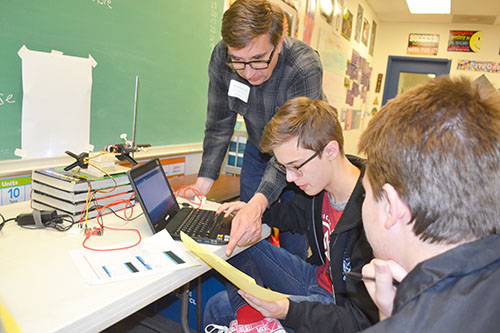
Joe Muskin (left), Mechanical Science and Engineering’s Outreach coordinator, helps a couple of Judah students trouble shoot their laser show.
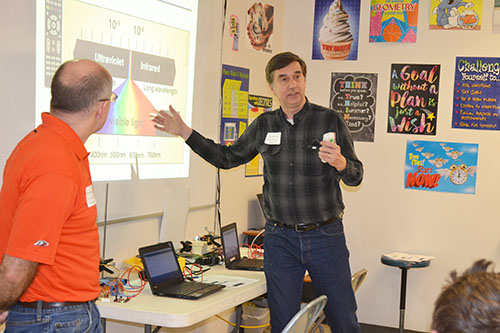
Joe Muskin (right) teaches the students about the light spectrum, including lasers.
Rather than just poring over a math textbook studying coordinates, or simply using graph paper to map them out, students at Judah Christian School used cutting-edge technology to learn about coordinates, courtesy of University of Illinois master teachers Joe Muskin and Adam Poetzel. On Thursday, November 21st, students from 11 different classes used coordinate math to design shapes which they then displayed using laser light shows. Not only was the activity educational and fun, but students would most likely never forget what they’d learned about coordinates. For example, as one student, Piper Hawk admitted: “You’ve gotta’ be specific with it.”
Teaching the students the avant-garde lesson were Adam Poetzel, an instructor from Curriculum & Instruction, and Joe Muskin, Mechanical Science and Engineering’s Outreach Coordinator. Passionate about STEM education outreach, the two had added the coordinate math element to a laser show project a nano@illinois RET teacher had created a couple of years ago. Since then, the lesson has evolved to include coordinate math, and the two have been presenting it at schools, tweaking it based on teacher and student input.
According to Kathleen Rice, the Judah math teacher who hosted the activity, all of school’s 7th–9th graders, half of the 10th–11th graders, and even a couple of seniors got to experience the coordinates/laser lesson. As part of the day-long event, not only Rice’s students from 7th and 8th grade math and geometry (grades 9–11) classes participated, but those of her fellow STEM teachers: Sheila Kirby’s STEM class for grades 9–12 and Nicole Hettmansberger’s Algebra 1 and Statistics classes.
Here’s how the activity worked. In previous lessons, students had learned how coordinates work, then used coordinate math and graph paper to design objects they wanted to project with the laser show. This produced a list of coordinates. Since the students had already learned the procedure of plotting points on a coordinate grid, Poetzel explains that the laser lesson takes that learning one step further: “This lesson provides an opportunity to use this knowledge for a relevant purpose and apply their skills to create their very own ‘light show.’ Students have to plan the path of the laser using their coordinates, and think strategically about the location and order of their desired points.”
Muskin and Poetzel first taught students about different kinds of light, specifically lasers. One important aspect they shared was about safety issues. “When working with any type of laser in a classroom, it is important to consider student safety,” Poetzel says. “To help create a safe environment, we secure the laser devices so they are not easily moved and also have an educational talk with the students about properties of light, lasers, and laser safety.”
To further ensure students’ safety, Muskin adds, “We use low-powered lasers as well. The power is low enough that a person’s blink reflex will protect their eyes from damage.”
Finally, they explained in detail how to enter the coordinates into the computer program. Once students understood the activity, they then meticulously entered their coordinates into the program which created a series of positions. These commands were then sent to the laser aimed at two mirrors mounted on Lego controllers, which directed it. The program made the controllers rotate, causing the reflected laser spot to move from one position to another, thus tracing out the patterns the students had defined. And because the laser was aimed at fluorescent paper, the light was briefly retained. The result? A really cool laser light show!
So, why go through so much effort just to teach some math? According to Rice, it was an engaging way for her students to not just learn coordinate math, but get immediate feedback if they’d done it wrong. “The short answer is that when they program the points in correctly, their design appears correctly—and it's pretty obvious if there is an error or not. It's also self-motivating to find/correct errors.” Plus, she says her students were not only interested in doing their design the first time, but they were also interested in improving on it: “making it more complex or ‘exact’—which causes more practice,” she adds.
Poetzel agrees about the “immediate-feedback” benefit the laser show provides. He says once students have uploaded their coordinates and see their light show, if the design does not match what they intended, it’s often because they made a small error in their coordinates. “This makes them problem solve to figure out which coordinates they mislabeled or typed incorrectly,” he reports. “Finding and fixing mistakes is an excellent way to learn, and students can see if their modifications were correct by looking at the new light show.”
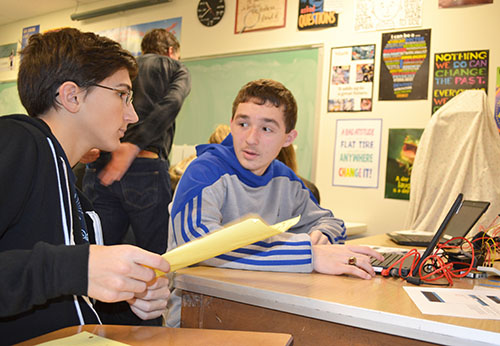
A team of students work on their show; one reads the coordinates while his teammate enters them into the program.
What were some of the challenges? For one, some students weren’t able to find their errors or had programmed their points in backwards. However, these were quickly fixed once a teacher got to them. Which brings up another challenge: sometimes students had to wait a bit because the classes, sometimes smaller classes combined, were larger than usual, thus 2–3 students shared a laser station. “Space was also a bit of an issue, but everyone was careful, so it worked,” adds Rice.
One concern the teachers had prior to the event actually turned out to be a plus: several students who are in the STEM class plus a math class were scheduled to come twice. “We thought that could be a problem,” Rice explains, but the students actually enjoyed having a second opportunity to create a different design or to improve their original.”
Although the coordinate math/laser show activity definitely wasn’t class as usual, Rice says the students did really well. “They listened to advice and started simple so they were able to see good results quickly and then made improvements from there.” She also appreciated Poetzel and Muskin’s instruction. “The presentation the guys gave was very age/ability appropriate, and they were high energy, so it caught/maintained the students’ interest very well. It was a great educational experience.”
“The kids did great!” agrees Poetzel. “Almost every single student was able to get their unique light show to work.”
What kind of designs did students come up with? As might be expected, some had a holiday theme. At various times, a Christmas tree, a star, or a snowman would light up across the room. Some designs involved letters: an I (for Illinois?), the letter H (the first letter of a student’s name?), or entire words, like ILL-INI, MATH, and STEM. Still other designs included a cross, a heart, and even more complex designs such as a maze, or…an elephant’s head!
Regarding the activity’s impact, Rice wasn’t sure. “I don't know,” she reports, “except I did not hear even one complaint, so it was definitely a positive experience for them, which can't help but make them open to more of the same in the future.”
In fact, rather than students whining about math class, Rice indicates that “Aha moments were abundant!” She says the students were able to pretty much see everything that was happening throughout the room, and there was a lot of excitement not just about their own group’s achievements, but other students’ as well. “I'd venture that everyone said something like ‘Oh!’ or ‘Wow!’ or ‘Look!’ at least once. There was also a lot of ‘Oh, here it is!’ when they found their mistakes, and excitement when their ‘fix’ actually worked. A lot of collaboration between students happened, too.”
Rice’s overall take on the day? “We all had a pretty great time…but I bet the guys were exhausted!” she acknowledges.
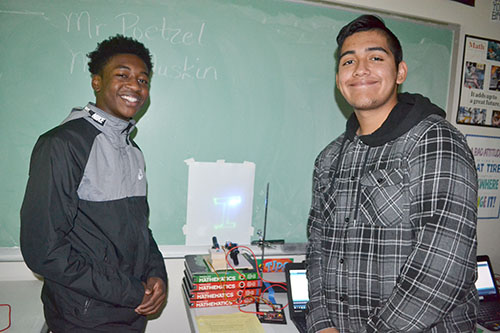
Two students proudly display their laser light show.
Another aspect that the instructors found rewarding was that students were appreciated the fact that the lessons weren’t “business as usual.” “Many students commented on how “cool” it was and that they wished they could do math like this more often,” Poetzel recalls. “Miss Rice said the students were talking about it the days after we left.”
While teaching eight sessions in one day was certainly ambitious, Poetzel and Muskin were spurred on by watching the students’ reactions when they had successfully created their laser designs. “It is always exciting as an educator to see students’ eyes widen, and smiles spread when they are successful and feel proud of what they accomplished,” Poetzel admits. “Throughout the day we saw a multitude of excited students who felt empowered by what they accomplished.”
The two also noted that they valued giving students real-world applications that allowed them to apply some of their new-found knowledge. “Allowing students to create something using the math and science they are learning helps them to see the applications of math and gets many more excited to engage in STEM activities and studies in the future.”
“It is always fantastic when we can make learning relevant to students,” Muskin agrees. “They see why it is important to learn things in math like coordinates so they can ‘communicate’ to the computer and have it create their light show. It is also wonderful when students see how science, math, and engineering all intersect.”
And the students seemed to find the lesson not only relevant and enlightening…but fun. For example, Nala Gallaher, a Judah High School sophomore, indicates that she really enjoyed the activity: “I thought it was pretty neat; it's really cool.” While they’re not currently studying coordinates in class, she indicates that they’ve done so in the past, and agrees that seeing coordinates demonstrated in an activity like the laser show helped them make sense of what they’d learned. Piper Hawk, also a sophomore, shares a key nugget that she learned about coordinates through this activity. “You’ve gotta be specific with it,” she explains.
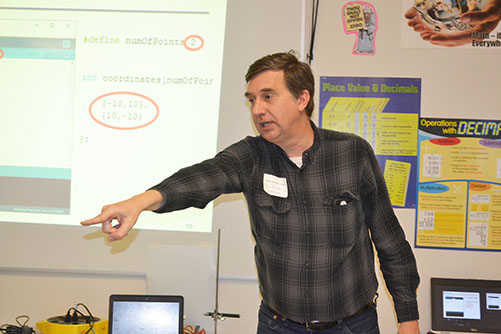
Joe Muskin interacts with a student during their presentation.
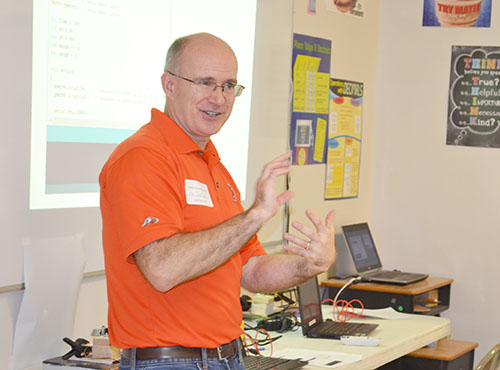
Adam Poetzel, an instructor from the Curriculum & Instruction Department, describes to the students how lasers work.
She was also pleasantly surprised that she was able to successfully make the laser show work. “Cause doing this, I did not think I did this right, but then I did! I was very surprised about that.”
One of the challenges of doing this project, according to Hawk? “Reading the directions, I guess.”
Poetzel agrees with Piper Hawk’s assessment that “You’ve gotta be specific with it,” along with the need to carefully read the directions. He also appreciates that students are gaining some important life-long character traits: persistence and perseverance.
“One thing I love about this lesson is that over half the students do not get their intended light show on their first attempt,” he admits. “When they begin their show, the projected design does not match what they intended. At this time they need to problem solve to figure out how to fix their show.”
He explains that they might have made a mistake when planning the coordinates, inputting the coordinates into the software, or in their use of required syntax in the software code. Whatever their mistake, he says, “They are motivated to find their errors and re-try their light show to see if it works. This is a great learning experience for students…to not give up when something doesn’t work, but to persevere and problem solve until a solution can be found.”
So how’d the partnership come about? Rice and Poetzel had met when she taught his daughters, then he began helping with Judah’s math team. Then at a recent ICTM (Illinois Council of Teachers of Mathematics) conference, Poetzel and Muskin presented this activity in a seminar. Though Rice missed the seminar, she discovered that they were doing the lesson in schools and invited them to Judah. “Since they were coming anyway, and there were gaps in my schedule…” she explains, she asked other teachers if they wanted to be included. They did. “Everyone jumped at the opportunity—so much so that the guys gave eight presentations straight!”
While it was definitely a full day, the instructors believed it was worth it, since they were helping the students to understand that they can indeed do STEM. According to Muskin: “The best part of the activity is when the students get their show to work, they then realize that engineering is something that they can do. It is something that they might want to consider as a career.”
Story and photographs by Elizabeth Innes, Communications Specialist, I-STEM Education Initiative.
More: 6-8 Outreach, MechSE, Judah Christian School, 2019
For additional I-STEM articles about laser lights, see:













.jpg)
















